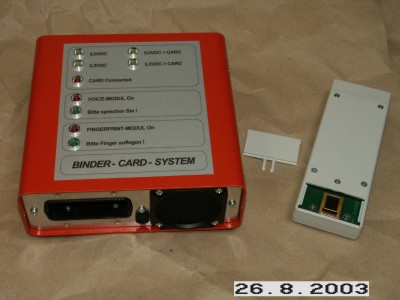|
Description of Binder Card System

1. Function:
A Binder Card
represents an passport check and customs officer in one. It can completely
identify its “owner”. It is completely useless for other persons.
It is capable
of sensibly processing information (user data, driving information or
similar) input by a random technical unit or “device” (auto, airplane, cash
vendor…) and thus together with the identification information to grant,
deny or later revoke single or multistage approval for certain operations of
the related facility. It continuously monitors the status using information
input (e.g. driving speed, flight altitude, or similar). Using this
information (and/or randomly) additional checks are initiated in continuous
operation. These originate from the card alone and not from the respective
technical unit.
The card is
capable of giving information about the technical unit to the user visually
or acoustically. It can also take and evaluate information of the user.
The device is always the medium, and (almost) never the starting point or
destination of information.
An exception
is formed, e.g. by the simulation program of the prototype that permits
emergency operation under restricted conditions (e.g. speed). Similar
exceptions will happen in almost all applications. Information recorded in
running operation and still being required (e.g. driving and resting time)
shall remain stored on the Binder Card. Since it has its own real time
clock it cannot be misled by related misinformation from outside.
All
information stored for the use of the card (hence PIN, voice sample,
fingerprint or iris scan) remain in the card. No central registry is
required (data protection!).
2. Hardware:
The Binder Card
prototype consists of 3 modules:
Control Unit,
Voice Recognition, Fingerprint Scanner.
Further
developments and other designs may also contain other systems to record
biometric data. The fact that the prototype has a finger sensor has purely
processing technological reasons and is not definitely required. Where the
sensor is located is not important, but moreover where the biometric data
are stored and compared.
A sensor on
the card is probably still safer against manipulation. The current
identification modules are standard types for general (experimental) uses.
Modules especially adapted to the Binder Card (use adapting is offered by
producers throughout, but of course from “xyz numbers”) can be matched
better to the task and be significantly smaller.
Presently the
control unit is a 386 micro PC that enhanced development. A smaller
solution is also here feasible (not only function and price but also
mechanically) so that a card size of about 54 x 85 x 6 mm (check card
format) could be expected.
The device
includes a box in which the Binder Card is inserted. The box is n o t
intelligent, i.e. it can only recognise that a Binder Card has been
inserted, supply its power and make connection to the PC (…and at least with
the prototype operate a few LEDs by the card). Currently the box gets power
from a mains power supply, but in reality surely from the device.
|